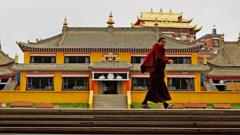The Kirti Monastery in Aba, Sichuan province, remains a focal point for Tibetan resistance, even as it sits under the watchful eyes of Chinese authorities. On the eve of the Dalai Lama's 90th birthday, the confrontation between Tibetan spirituality and Chinese control becomes increasingly pronounced. A monk, cloaked in crimson robes, shared his concerns: "Things here are not good for us." His cautious dialogue is a testament to the dangers of speaking out in a region fraught with surveillance and repression, where even mentioning the Dalai Lama can lead to dire consequences.
Beijing's long-standing presence in Tibet, marked by heavy investments in infrastructure and military oversight, has not dampened the resolve of local Tibetans. The Kirti Monastery has a rich history of resistance; it was here that self-immolations occurred in protest against Chinese rule. These acts of despair have left a haunting legacy in Aba, known as "Martyr's row," where violence between Tibetans and Chinese paramilitary forces has tragically escalated in the past.
Much has changed since the protests of 2008, following which surveillance has grown more invasive, making it nearly impossible to glean accurate information about conditions in Tibet. Conversations with monks at the monastery reveal a deep yearning for basic human rights and autonomy, accompanied by the stark realization of loss and oppression. "The Chinese government has poisoned the air in Tibet," one monk lamented, voicing sentiments echoed throughout the closely monitored religious community.
Uproar within the Tibetan community revolves around the Dalai Lama's recent proclamation regarding his succession. Although living in exile, this beloved leader has emphasized that his successor will be chosen based on merit and not under Chinese scrutiny, a claim Beijing vehemently opposes. The Chinese Communist Party has sought to control these religious traditions, asserting that any future Dalai Lama must align with their version of Tibetan identity—a bid that could fracture traditional beliefs.
As the landscape outside the monastery shows a blending of modern Chinese development and vibrant Tibetan culture, locals fear indoctrination in state-run schools may endanger the essence of their heritage. New regulations restrict Tibetan children to Mandarin instruction in state schools, neglecting their native language and beliefs.
Historical tensions suggest that both Tibetan Buddhism and Chinese political ambitions are headed for a collision course. With the Dalai Lama's statement regarding his successor, concerns deepen about where the next spiritual leader will emerge and who will claim rightful authority over the Tibetan people.
The complex intertwining of Tibetan identity, faith, and the pressures from the Chinese state showcases the multifaceted nature of resistance efforts. As we navigate through the bustling streets of Aba, behind the veneer of tourism, the heart of Tibetan culture beats defiantly, reminding us that the quest for self-determination persists amidst grave adversity.




















